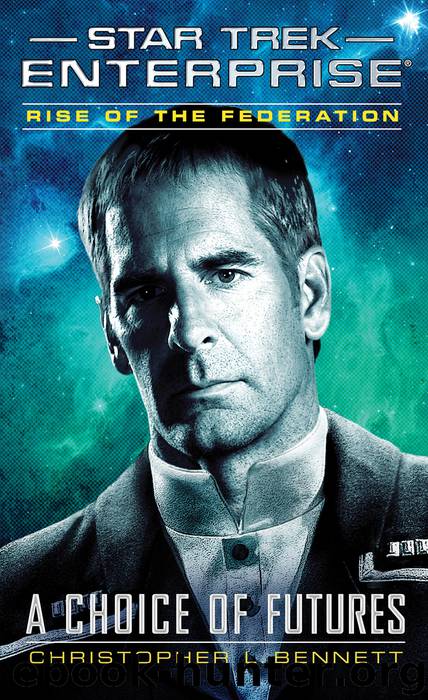Star Trek: Enterprise - 015 - Rise of the Federation: A Choice of Futures by Christopher L. Bennett

Author:Christopher L. Bennett [Bennett, Christopher L.]
Language: eng
Format: epub, mobi
Tags: Action & Adventure, Fiction, General, Science Fiction, Media Tie-In, Space Opera
ISBN: 9781476706740
Google: EKazNAEACAAJ
Amazon: 1476706743
Barnesnoble: 1476706743
Publisher: Pocket Books/Star Trek
Published: 2013-06-25T07:00:00+00:00
10
April 2, 2163
U.S.S. Pioneer
“ENGINEERING TO BRIDGE,” ALAN Sheehan’s voice came over the intercom. “We’ve completed the coil calibrations and the reactor’s warming up. We’ll be ready for warp within two minutes.”
Finally, Malcolm Reed thought, though he kept it out of his voice as he said, “Thank you, Commander. Stand by.” He turned to the engineering station. “Doctor Dax, I hope you’re confident it will actually work this time.”
“Well, it should, Captain,” the diffident Trill replied. “Most likely. I think we’re getting the hang of your coils now.” He shrugged. “We’ll see, anyway.”
Coming from Dax, Reed reflected, that was a vote of high confidence. At least he sincerely hoped it was. It had been a frustrating few weeks as Dax and his team had gone through multiple failed attempts to balance the warp drive with the shields. No matter how many simulations they had run, the actual results had failed to match. Dax had attributed it to the “idiosyncratic” warp coil–manufacturing process used by Earth engineers; each individual coil was subtly different, with its own “personality,” and calibrating them to work together was a trial-and-error process—especially when they were required to perform in a way they hadn’t been designed to. Apparently Cochrane-style warp fields were too finely tuned, too sensitive to the gravimetric interference of a deflector envelope; other species’ drives produced warp fields that could more easily compensate for the effect through some sort of built-in cushion in their space-time geometry. Dax had been trying to add similar compensatory layers to Pioneer’s warp field, but aligning the coils to produce the necessary interference patterns had proved challenging. If anything, the required geometry was even more sensitive to fluctuations than a normal Cochrane field. But Dax’s team was confident that once they found the right balance, it could be “locked in” and more easily replicated in other ships, or at least be a starting point for future refinements.
In his darker hours of fatigue and frustration, Reed had wondered if Starfleet would be better off ditching Cochrane drives altogether and building their future ships around Andorian nacelles. But while Dax was open to a hybrid design, he still felt (and Commodore Jefferies agreed) that the twin-outrigger Cochrane drive was the most versatile warp configuration around—though he confessed that the same lability that made it so adaptable also made it difficult to lock the changes down now.
At the helm, Mayweather finished his discussion with Ensign Tallarico and rose to address the captain. “We’ve got the course laid in,” he said. “Should be as smooth a ride as we can manage—no major masses or energy sources within two light-years, no significant subspace density gradients that we know of.” They were starting in interstellar space already to minimize the influence of stellar gravity and radiation on the warp field, giving Dax the purest baseline possible with which to work.
The Trill scientist jumped a bit as the engineering console gave off a signal tone. “Um . . . engineering reports ready, sir.”
Reed waited a moment, then asked, “So are we good to go?”
“Oh! Yes, of course, Captain.
Download
Star Trek: Enterprise - 015 - Rise of the Federation: A Choice of Futures by Christopher L. Bennett.mobi
This site does not store any files on its server. We only index and link to content provided by other sites. Please contact the content providers to delete copyright contents if any and email us, we'll remove relevant links or contents immediately.
Sita - Warrior of Mithila (Book 2 of the Ram Chandra Series) by Amish(54549)
The Crystal Crypt by Dick Philip K(36608)
Cat's cradle by Kurt Vonnegut(15101)
Always and Forever, Lara Jean by Jenny Han(14713)
Ready Player One by Cline Ernest(14440)
The Last by Hanna Jameson(10101)
Year One by Nora Roberts(9618)
Persepolis Rising by James S. A. Corey(9150)
The remains of the day by Kazuo Ishiguro(8748)
Red Rising by Pierce Brown(8525)
Never let me go by Kazuo Ishiguro(8525)
Dark Space: The Second Trilogy (Books 4-6) (Dark Space Trilogies Book 2) by Jasper T. Scott(8051)
The handmaid's tale by Margaret Atwood(7637)
The Circle by Dave Eggers(6988)
Frank Herbert's Dune Saga Collection: Books 1 - 6 by Frank Herbert(6865)
The Testaments by Margaret Atwood(6671)
Legacy by Ellery Kane(6519)
Pandemic (The Extinction Files Book 1) by A.G. Riddle(6409)
Six Wakes by Mur Lafferty(6061)
